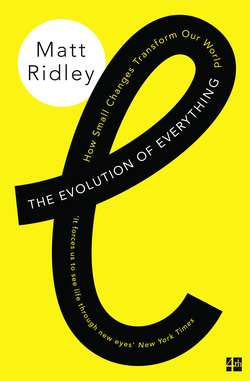Читать книгу The Evolution of Everything: How Small Changes Transform Our World - Matt Ridley, Matt Ridley - Страница 29
4 The Evolution of Genes
ОглавлениеFor certainly the elements of things do not collect
And order their formations by their cunning intellect,
Nor are their motions something they agree upon or propose;
But being myriad and many-mingled, plagued by blows
And buffeted through the universe for all time past,
By trying every motion and combination, they at last,
Fell into the present form in which the universe appears.
Lucretius, De Rerum Natura, Book 1, lines 1021–7
An especially seductive chunk of current ignorance is that concerning the origin of life. For all the confidence with which biologists trace the emergence of complex organs and organisms from simple proto-cells, the first emergence of those proto-cells is still shrouded in darkness. And where people are baffled, they are often tempted to resort to mystical explanations. When the molecular biologist Francis Crick, that most materialist of scientists, started speculating about ‘panspermia’ in the 1970s – the idea that life perhaps originated elsewhere in the universe and got here by microbial seeding – many feared that he was turning a little mystical. In fact he was just making an argument about probability: that it was highly likely, given the youth of the earth relative to the age of the universe, that some other planet got life before us and infected other solar systems. Still, he was emphasising the impenetrability of the problem.
Life consists of the capacity to reverse the drift towards entropy and disorder, at least locally – to use information to make local order from chaos while expending energy. Essential to these three skills are three kinds of molecule in particular – DNA for storing information, protein for making order, and ATP as the medium of energy exchange. How these came together is a chicken-and-egg problem. DNA cannot be made without proteins, nor proteins without DNA. As for energy, a bacterium uses up fifty times its own body weight in ATP molecules in each generation. Early life must have been even more profligate, yet would have had none of the modern molecular machinery for harnessing and storing energy. Wherever did it find enough ATP?
The crane that seems to have put these three in place was probably RNA, a molecule that still plays many key roles in the cell, and that can both store information like DNA, and catalyse reactions like proteins do. Moreover, RNA is made of units of base, phosphate and ribose sugar, just as ATP is. So the prevailing theory holds that there was once an ‘RNA World’, in which living things had RNA bodies with RNA genes, using RNA ingredients as an energy currency. The problem is that even this system is so fiendishly complex and interdependent that it’s hard to imagine it coming into being from scratch. How, for example, would it have avoided dissipation: kept together its ingredients and concentrated its energy without the boundaries provided by a cell membrane? In the ‘warm little pond’ that Charles Darwin envisaged for the beginning of life, life would have dissolved away all too easily.
Don’t give up. Until recently the origin of the RNA World seemed so difficult a problem that it gave hope to mystics; John Horgan wrote an article in Scientific American in 2011 entitled ‘Psst! Don’t Tell the Creationists, But Scientists Don’t Have a Clue How Life Began’.
Yet today, just a few years later, there’s the glimmer of a solution. DNA sequences show that at the very root of life’s family tree are simple cells that do not burn carbohydrates like the rest of us, but effectively charge their electrochemical batteries by converting carbon dioxide into methane or the organic compound acetate. If you want to find a chemical environment that echoes the one these chemi-osmotic microbes have within their cells, look no further than the bottom of the Atlantic Ocean. In the year 2000, explorers found hydrothermal vents on the mid-Atlantic ridge that were quite unlike those they knew from other geothermal spots on the ocean floor. Instead of very hot, acidic fluids, as are found at ‘black-smoker’ vents, the new vents – known as the Lost City Hydrothermal Field – are only warm, are highly alkaline, and appear to last for tens of thousands of years. Two scientists, Nick Lane and William Martin, have begun to list the similarities between these vents and the insides of chemi-osmotic cells, finding uncanny echoes of life’s method of storing energy. Basically, cells store energy by pumping electrically charged particles, usually sodium or hydrogen ions, across membranes, effectively creating an electrical voltage. This is a ubiquitous and peculiar feature of living creatures, but it appears it might have been borrowed from vents like those at Lost City.
Four billion years ago the ocean was acidic, saturated with carbon dioxide. Where the alkaline fluid from the vents met the acidic water, there was a steep proton gradient across the thin iron-nickel-sulphur walls of the pores that formed at the vents. That gradient had a voltage very similar in magnitude to the one in a modern cell. Inside those mineral pores, chemicals would have been trapped in a space with abundant energy, which could have been used to build more complex molecules. These in turn – as they began to accidentally replicate themselves using the energy from the proton gradients – became gradually more susceptible to a pattern of survival of the fittest. And the rest, as Daniel Dennett would say, is algorithm. In short, an emergent account of the origin of life is almost within reach.
